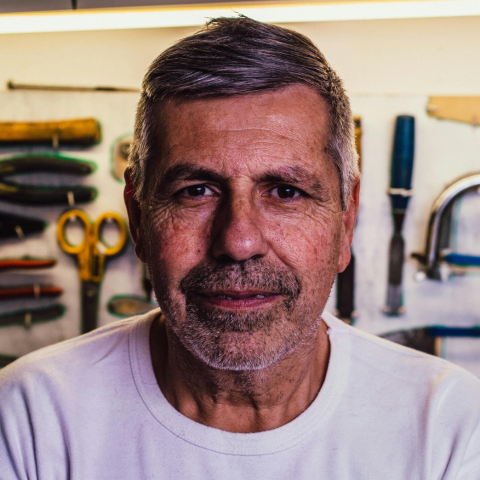
Awareness Before Action: Every Vascular Journey Begins With a First Step
This story highlights the experience of a patient who became aware of Peripheral Artery Disease (PAD) through the public awareness campaign "Pulse on PAD." After discussing their concerns and risk factors with their primary care physician, they underwent a PAD screening along with additional tests to evaluate their overall vascular health.
The Why
A couple of months ago a public awareness media campaign entitled “Pulse on PAD” caught my attention. I heard that “If you are 65 years of age, you are reaching peak vascular disease age, and you should ask your doctor about your circulation and to check your feet.” I had my annual physical exam coming up in a few weeks and made a note to ask my primary care doctor about my vascular health and if I should get screened, to at least get a baseline as to how my arteries and veins are holding up for my age. And so, I asked.
My primary care doctor asked me if I had any concerns or was having any symptoms such as difficulty walking longer distances, experiencing pain while walking, etc. I haven’t noticed any real issues or symptoms other than a bit more muscle cramping or soreness than I used to have. Mostly, I told him, since I recently heard about Peripheral Artery Disease (PAD), I wanted to make sure I wasn’t in any early stages.
During the exam my doctor examined my feet for any signs of sores or numbness and felt for my foot pulses. He mentioned that he had trouble finding strong pulses in my feet but noted no other sores or signs of circulation trouble. He also said I had a “strong capillary refill response,” in my toes, meaning when pressure is applied to stop blood flow, the color returns to pink quickly once the pressure is released. His conclusion was that unless I was having noticeable symptoms it is unlikely I have PAD, or developing PAD, however, since I had some family history of heart disease (my Dad), and since he could not get a good strong pulse from my feet by feel, it was reasonable to do some testing to see where I am at regarding vascular health.
He suggested 4 tests:
-
Cardiac CT Calcium Scoring: Measures any blockage or build-up in your heart arteries.
-
Ankle Brachial Index (ABI): Measures blood pressure differences in your arms and lower legs and toes, to ensure circulation is reaching your lower extremities.
-
Carotid Artery Scan: Assess if I have advanced build up or blockage in my neck arteries, which may cause stroke.
-
An AAA Screen: Assess if I have developed an abdominal aortic aneurysm (AAA), a balloon pocket in my aorta that could grow and burst down the road. This is rare, but if you have ever smoked in your life, even 20-30 years ago, you are male, and you have some family history, it is a good thing to rule out.
I requested a referral to a local vascular surgeon to schedule these tests with. I felt this was important as vascular surgeons have the most extensive training of artery and vein health and understand the full context of all phases of vascular disease. I wanted to make sure I got the full big picture first, before I had to make any potential decisions about care, if it turned out to be necessary. The tests were scheduled.
All 4 of these tests are simple, non-invasive, scans so there is no physical pain or discomfort at all. Was it challenging to work through the health system to get everything scheduled? Yes, of course. Did I need to do these tests on multiple days? Yes, of course. But I was able to get 3 done in one day which was helpful. Due to my age, some family history, and presence of weak foot pulses, all tests were covered by insurance. This may not be the case for all.
The Tests
Cardiac CT Calcium Scoring
This test was done in my local community outpatient hospital Radiology Department. You are asked to lay down on your back on a table that slides into a CT scan machine and the machine prompts you to take a deep breath in and hold it a couple times for a few seconds. From beginning to end, the test took less than 10 minutes. Results are reviewed by a Radiologist and were available in 12 hours.
AAA Screening
This test was also done in my local community outpatient Radiology Department. You are asked to lay down on your back on a Table. An Ultrasound Technician squirts some “gel” onto a scanning device and moves the device up and down your mid-section looking for signs of abnormality in your abdominal aorta. The technician takes measurements, pictures, and recordings of what they observe. The test from beginning to end took 10 minutes. The results are read by a Radiologist and were available in 48 hours.
ABI
This test was done in an “outpatient vascular lab” affiliated with my local community hospital, but in a different location. The test is performed by an Ultrasound Technician. Since I noted that my primary doctor could not really feel strong pulses the Technician first took an ultrasound device that picks up sound and searched for my foot pulses. After 10-15 seconds of silence, I heard the Technician say “oh” and then I heard the comforting strong “swishing” sound of blood flow. “That answers that question” the Technician said with a smile. “Your anatomy has your arteries under your main foot bone, so you need to work a little to find it.” The Technician made a note of this, so any future Technician is aware of it. The Technician then proceeded to take my blood pressure in both arms, took my blood pressure near my ankle with a specially designed cuff, and also placed a small cuff on my big toe. The Technician took all kinds of measurements and recordings. Total time for the test was about 20 minutes. The results were read by a Radiologist and made available to me in 48 hours.
Carotid Artery Scan
This test was done in the same setting as the ABI, on the same day. It is performed by an Ultrasound Technician and was the most extensive of the tests. I was asked to lay on a Table on each side while the Technician squirted gel on the ultrasound device and did an extensive series of sound and visual measurements of the blood flow in my neck arteries. This test took 30 minutes. The results were read by a Radiologist and made available to me in 48 hours.
The Result
As explained to me by my vascular surgeon all of us develop signs of vascular disease as we age, it is a normal part of the aging process. How well you have taken care of yourself with diet and exercise over your life, and your genetics, plays a major role in how slowly or quickly you may develop vascular disease.
My results were promising. My overall vascular health mapped out to be the health one might expect for someone 15-years younger than I am. Did I have some calcium build up in my heart artery? Yes. Did I have some build up, blockage, and hardening within the artery walls in my neck? Yes. We all do as we age, but my levels are age appropriate, and I seem to be even a little ahead of the game. This was somewhat surprising to me as I have been no saint when it comes to taking care of myself. “Good genes” noted my vascular surgeon.
My AAA…perfect, no sign of an issue.
My ABI, which is an excellent indicator of developing Peripheral Arterial Disease (PAD), was also normal. A score below 0.9 begins a discussion, mine was 1.1. So, my aches and pains in my legs while walking and exercising are just that, aches and pains.
It is not recommended that everyone get screened for developing vascular disease unless they have some symptoms like pain while walking that stops when you stop walking, or worries, such as a family history of heart or vascular disease. I am glad my awareness was heightened. I am glad I was screened. I have the comfort of a baseline to work from now, the comfort of knowing I am doing ok, much greater awareness and a plan I developed with my vascular surgeon to keep it that way!
I would recommend that everyone over 60 begin having a discussion with their doctor about vascular health, to get screened as appropriate, and to have a discussion with a vascular surgeon about your vascular journey.
